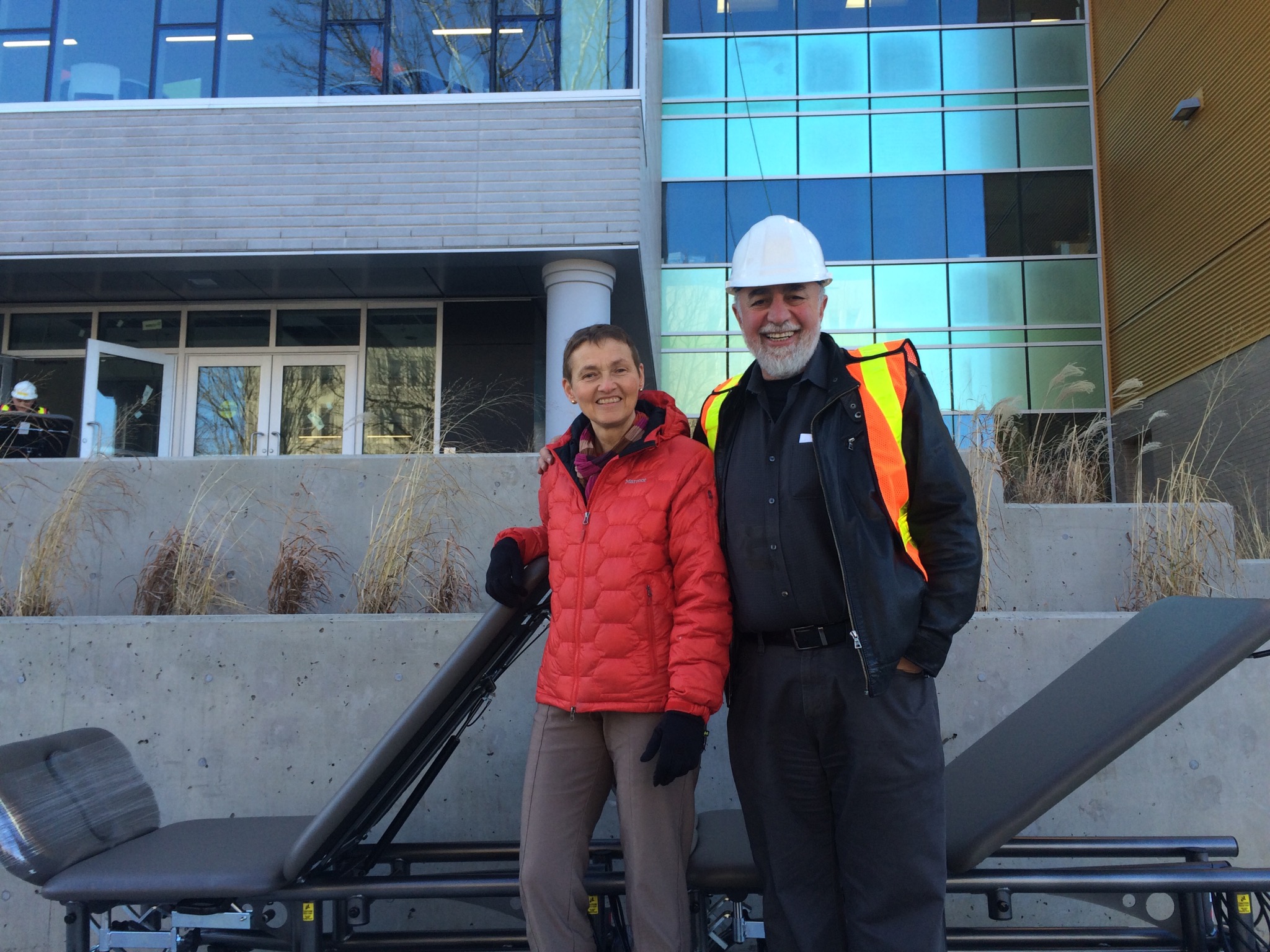Winter 2016 Director's Message
 [Above] Dr. Anne Fenety stands outside the newly opened CHEB Building with Cardon Rehabilitation & Medical Equipment Ltd.'s Mardig Savadjian.
[Above] Dr. Anne Fenety stands outside the newly opened CHEB Building with Cardon Rehabilitation & Medical Equipment Ltd.'s Mardig Savadjian.
By: Anne Fenety, Director of the School of Physiotherapy
Years ago in our BSc Physiotherapy program, we created an in-class exercise called “Talking to Decision Makers.” We mocked up conversations where lab demonstrators and professors 'pretended' to be decision makers regarding client care (e.g. MD’s, OTs, insurers, etc.). Physiotherapy students then mocked-up a phone call to a 'pretend' doctor to discuss the need for a test (e.g. X-ray) or 'pretended' to discuss a patient discharge plan with the 'pretend' occupational therapist. A good learning experience, but scant in collaborative health team building and way too much pretending.
Today in our MSc Physiotherapy program, students in physiotherapy, medicine, and occupational therapy, for example, could replicate that exercise—without pretending. They would do this exercise in Dalhousie’s collaborative Interprofessional Health Education (IPHE) program, which has been successfully implemented for the past decade. The IPHE program was greatly enhanced on December 1st, 2015 at the standing-room-only, grand opening of the Collaborative Health Education Building (CHEB). Some came to hear Premier Stephen McNeil’s opening remarks. Some came to see the superb building. But others?
I expect that most attendees simply shared a collective interest in the success of interprofessional health education, defined by the World Health Organization (2010) as occurring “when two or more professions learn about, from, and with each other to enable effective collaboration and improve health outcomes”. So does effective collaboration matter? Clinicians would know that improved collaboration improves patient care and safety, decreases complications, and reduces interprofessional conflict, among other benefits. For the health care decision makers in the room, some key benefits of collaboration are decreased hospital admissions, patients’ lengths–of-stay and clinician errors. Physiotherapists at the CHEB opening might recall the Canadian Physiotherapy Association’s fundamental position that “Inter-professional collaboration is essential for effective and efficient patient and family-centered care.”[1]
For all these benefits, we need the CHEB to facilitate IPHE activities; as a place dedicated to collaboration. For aspiring physiotherapists at Dalhousie, interprofessional health education will begin in the School and the CHEB, but it won’t end there. According to the Faculty of Health Professions on-line Interprofessional Collaboration in Practice guide, “what really brings IPHE to life for students is relevant and meaningful teamwork experiences in the practice setting.”[2] Check out the link below to learn more about how to provide valuable IPHE clinical experiences for PT students you will be supervising. I guarantee you it will be a valuable experience for you too.
In closing, a gigantic ‘Thanks’ to Dr. Will Webster, Dean of the Faculty of Health Professions for his vision of the CHEB Building and his drive to see it become reality.
Best wishes for an inspiring and successful 2016 …. in collaborative education and collaborative practice.
_________________________________________________________________________________________
[1] Canadian Physiotherapy Association, 2012 Position Statement: Inter-Professional Collaboration and Practice [https://www.physiotherapy.ca/getmedia/7f59bd2f-68aa-45c4-aa67-4ca63ccc58a3/Inter-professional-Collaboration_en.pdf.aspx]
[2] Faculty of Health Professions, Dalhousie University: Interprofessional Collaboration in Practice: A Guide for Strengthening Student Learning Experiences [http://www.dal.ca/content/dam/dalhousie/pdf/healthprofessions/Interprofessional%20Health%20Education/Facilitator%20Guide%20FINAL%20-%20with%20links.pdf]
